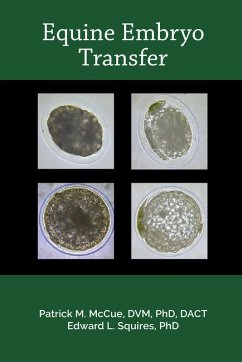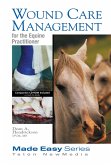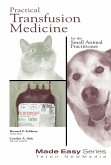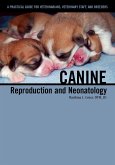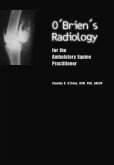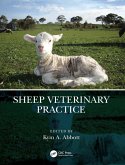53,95 €
53,95 €
inkl. MwSt.
Sofort per Download lieferbar

27 °P sammeln
53,95 €
Als Download kaufen

53,95 €
inkl. MwSt.
Sofort per Download lieferbar

27 °P sammeln
Jetzt verschenken
Alle Infos zum eBook verschenken
53,95 €
inkl. MwSt.
Sofort per Download lieferbar
Alle Infos zum eBook verschenken

27 °P sammeln
- Format: PDF
- Merkliste
- Auf die Merkliste
- Bewerten Bewerten
- Teilen
- Produkt teilen
- Produkterinnerung
- Produkterinnerung

Bitte loggen Sie sich zunächst in Ihr Kundenkonto ein oder registrieren Sie sich bei
bücher.de, um das eBook-Abo tolino select nutzen zu können.
Hier können Sie sich einloggen
Hier können Sie sich einloggen
Sie sind bereits eingeloggt. Klicken Sie auf 2. tolino select Abo, um fortzufahren.

Bitte loggen Sie sich zunächst in Ihr Kundenkonto ein oder registrieren Sie sich bei bücher.de, um das eBook-Abo tolino select nutzen zu können.
This book briefly reviews the history of equine embryo transfer, covering in clinically practical terms the techniques, equipment, and management protocols currently in use. Embryo transfer has become a big business, especially for breeding racing stock (horses and camels), and is therefore a very important aspect of equine practice. Ed Squires and
- Geräte: PC
- mit Kopierschutz
- eBook Hilfe
- Größe: 30.09MB
Andere Kunden interessierten sich auch für
![Animal Welfare in a Pandemic (eBook, PDF) Animal Welfare in a Pandemic (eBook, PDF)]() John T. HancockAnimal Welfare in a Pandemic (eBook, PDF)50,95 €
John T. HancockAnimal Welfare in a Pandemic (eBook, PDF)50,95 €![Wound Care Management for the Equine Practitioner (Book+CD) (eBook, PDF) Wound Care Management for the Equine Practitioner (Book+CD) (eBook, PDF)]() Dean A. HendricksonWound Care Management for the Equine Practitioner (Book+CD) (eBook, PDF)49,95 €
Dean A. HendricksonWound Care Management for the Equine Practitioner (Book+CD) (eBook, PDF)49,95 €![Practical Transfusion Medicine for the Small Animal Practitioner (eBook, PDF) Practical Transfusion Medicine for the Small Animal Practitioner (eBook, PDF)]() Bernard FeldmanPractical Transfusion Medicine for the Small Animal Practitioner (eBook, PDF)45,95 €
Bernard FeldmanPractical Transfusion Medicine for the Small Animal Practitioner (eBook, PDF)45,95 €![Canine Reproduction and Neonatology (eBook, PDF) Canine Reproduction and Neonatology (eBook, PDF)]() Marthina L. GreerCanine Reproduction and Neonatology (eBook, PDF)63,95 €
Marthina L. GreerCanine Reproduction and Neonatology (eBook, PDF)63,95 €![O'Brien's Radiology for the Ambulatory Equine Practitioner (eBook, PDF) O'Brien's Radiology for the Ambulatory Equine Practitioner (eBook, PDF)]() Timothy O'BrienO'Brien's Radiology for the Ambulatory Equine Practitioner (eBook, PDF)74,95 €
Timothy O'BrienO'Brien's Radiology for the Ambulatory Equine Practitioner (eBook, PDF)74,95 €![Sheep Veterinary Practice (eBook, PDF) Sheep Veterinary Practice (eBook, PDF)]() Sheep Veterinary Practice (eBook, PDF)131,95 €
Sheep Veterinary Practice (eBook, PDF)131,95 €![Global One Health and Infectious Diseases (eBook, PDF) Global One Health and Infectious Diseases (eBook, PDF)]() Global One Health and Infectious Diseases (eBook, PDF)65,95 €
Global One Health and Infectious Diseases (eBook, PDF)65,95 €-
-
-
This book briefly reviews the history of equine embryo transfer, covering in clinically practical terms the techniques, equipment, and management protocols currently in use. Embryo transfer has become a big business, especially for breeding racing stock (horses and camels), and is therefore a very important aspect of equine practice. Ed Squires and
Dieser Download kann aus rechtlichen Gründen nur mit Rechnungsadresse in A, B, BG, CY, CZ, D, DK, EW, E, FIN, F, GR, HR, H, IRL, I, LT, L, LR, M, NL, PL, P, R, S, SLO, SK ausgeliefert werden.
Produktdetails
- Produktdetails
- Verlag: Taylor & Francis eBooks
- Seitenzahl: 184
- Erscheinungstermin: 18. Februar 2015
- Englisch
- ISBN-13: 9781498734769
- Artikelnr.: 48421349
- Verlag: Taylor & Francis eBooks
- Seitenzahl: 184
- Erscheinungstermin: 18. Februar 2015
- Englisch
- ISBN-13: 9781498734769
- Artikelnr.: 48421349
- Herstellerkennzeichnung Die Herstellerinformationen sind derzeit nicht verfügbar.
Patrick M. McCue, Edward L. Squires
Contents 1. Introduction General Introduction (i.e. what is ET) Advantages
and uses of embryo transfer Changes in the ET Industry Breed regulations
(include a Table of most major breeds; ET, frozen embryos, etc.) Per cycle
ET Success = Embryo Collection Rate (50-60%) x Embryo Transfer Pregnancy
Rate (70-80%)Goals of the Manual 2. History of equine embryo transfer
Livestock Horses Domestic horses as surrogates for endangered equids(?) 3.
Reproductive Anatomy and Physiology of the MareAnatomy of the mare
Physiology of the estrous cycle Physiology of early embryonic development
and early pregnancy 4. Management of the donor mare Selection of the donor
Evaluation of the donor (BSE)Management and Day of breeding (fresh, cooled,
frozen semen) Palpation/ultrasound examinations relative to flush; daily vs
every 6-8 hrs for frozen semen; BID if goal is to collect a small embryo at
day 6.5 for cryopreservation Induction of ovulation (hCG and deslorelin)
Donor mare management (PMIE, fluid, etc.)Estrous cycle control (Lights,
P&E, PGF, hCG, Deslorelin, Regumate) Allow a mare to carry to term by
approximately 10 years of age Allowing mare to carry own every 3-4 years
Effect of repeated flushing on uterine health and embryo recovery # flushes
per year recommendedFertility of mares after flushing (i.e. same
season)Problem mares (i.e. PMIE, etc.) Maiden mares (young vs older)Post
partum mares (i.e. flushing on foal heat) 5.
SuperovulationHistoryTechniques EFSH Optimal follicle size at onset
Problems - same stallion vs. goal of different stallions Not every mare
responds to FSHPAF's and HAF's 6. Embryo Collection Equipment (Box Table)
Facilities (stocks vs stall, etc.) Procedure; (incl. clean out and wash up)
Ultrasound prior to flush in problem
and uses of embryo transfer Changes in the ET Industry Breed regulations
(include a Table of most major breeds; ET, frozen embryos, etc.) Per cycle
ET Success = Embryo Collection Rate (50-60%) x Embryo Transfer Pregnancy
Rate (70-80%)Goals of the Manual 2. History of equine embryo transfer
Livestock Horses Domestic horses as surrogates for endangered equids(?) 3.
Reproductive Anatomy and Physiology of the MareAnatomy of the mare
Physiology of the estrous cycle Physiology of early embryonic development
and early pregnancy 4. Management of the donor mare Selection of the donor
Evaluation of the donor (BSE)Management and Day of breeding (fresh, cooled,
frozen semen) Palpation/ultrasound examinations relative to flush; daily vs
every 6-8 hrs for frozen semen; BID if goal is to collect a small embryo at
day 6.5 for cryopreservation Induction of ovulation (hCG and deslorelin)
Donor mare management (PMIE, fluid, etc.)Estrous cycle control (Lights,
P&E, PGF, hCG, Deslorelin, Regumate) Allow a mare to carry to term by
approximately 10 years of age Allowing mare to carry own every 3-4 years
Effect of repeated flushing on uterine health and embryo recovery # flushes
per year recommendedFertility of mares after flushing (i.e. same
season)Problem mares (i.e. PMIE, etc.) Maiden mares (young vs older)Post
partum mares (i.e. flushing on foal heat) 5.
SuperovulationHistoryTechniques EFSH Optimal follicle size at onset
Problems - same stallion vs. goal of different stallions Not every mare
responds to FSHPAF's and HAF's 6. Embryo Collection Equipment (Box Table)
Facilities (stocks vs stall, etc.) Procedure; (incl. clean out and wash up)
Ultrasound prior to flush in problem
Contents 1. Introduction General Introduction (i.e. what is ET) Advantages
and uses of embryo transfer Changes in the ET Industry Breed regulations
(include a Table of most major breeds; ET, frozen embryos, etc.) Per cycle
ET Success = Embryo Collection Rate (50-60%) x Embryo Transfer Pregnancy
Rate (70-80%)Goals of the Manual 2. History of equine embryo transfer
Livestock Horses Domestic horses as surrogates for endangered equids(?) 3.
Reproductive Anatomy and Physiology of the MareAnatomy of the mare
Physiology of the estrous cycle Physiology of early embryonic development
and early pregnancy 4. Management of the donor mare Selection of the donor
Evaluation of the donor (BSE)Management and Day of breeding (fresh, cooled,
frozen semen) Palpation/ultrasound examinations relative to flush; daily vs
every 6-8 hrs for frozen semen; BID if goal is to collect a small embryo at
day 6.5 for cryopreservation Induction of ovulation (hCG and deslorelin)
Donor mare management (PMIE, fluid, etc.)Estrous cycle control (Lights,
P&E, PGF, hCG, Deslorelin, Regumate) Allow a mare to carry to term by
approximately 10 years of age Allowing mare to carry own every 3-4 years
Effect of repeated flushing on uterine health and embryo recovery # flushes
per year recommendedFertility of mares after flushing (i.e. same
season)Problem mares (i.e. PMIE, etc.) Maiden mares (young vs older)Post
partum mares (i.e. flushing on foal heat) 5.
SuperovulationHistoryTechniques EFSH Optimal follicle size at onset
Problems - same stallion vs. goal of different stallions Not every mare
responds to FSHPAF's and HAF's 6. Embryo Collection Equipment (Box Table)
Facilities (stocks vs stall, etc.) Procedure; (incl. clean out and wash up)
Ultrasound prior to flush in problem
and uses of embryo transfer Changes in the ET Industry Breed regulations
(include a Table of most major breeds; ET, frozen embryos, etc.) Per cycle
ET Success = Embryo Collection Rate (50-60%) x Embryo Transfer Pregnancy
Rate (70-80%)Goals of the Manual 2. History of equine embryo transfer
Livestock Horses Domestic horses as surrogates for endangered equids(?) 3.
Reproductive Anatomy and Physiology of the MareAnatomy of the mare
Physiology of the estrous cycle Physiology of early embryonic development
and early pregnancy 4. Management of the donor mare Selection of the donor
Evaluation of the donor (BSE)Management and Day of breeding (fresh, cooled,
frozen semen) Palpation/ultrasound examinations relative to flush; daily vs
every 6-8 hrs for frozen semen; BID if goal is to collect a small embryo at
day 6.5 for cryopreservation Induction of ovulation (hCG and deslorelin)
Donor mare management (PMIE, fluid, etc.)Estrous cycle control (Lights,
P&E, PGF, hCG, Deslorelin, Regumate) Allow a mare to carry to term by
approximately 10 years of age Allowing mare to carry own every 3-4 years
Effect of repeated flushing on uterine health and embryo recovery # flushes
per year recommendedFertility of mares after flushing (i.e. same
season)Problem mares (i.e. PMIE, etc.) Maiden mares (young vs older)Post
partum mares (i.e. flushing on foal heat) 5.
SuperovulationHistoryTechniques EFSH Optimal follicle size at onset
Problems - same stallion vs. goal of different stallions Not every mare
responds to FSHPAF's and HAF's 6. Embryo Collection Equipment (Box Table)
Facilities (stocks vs stall, etc.) Procedure; (incl. clean out and wash up)
Ultrasound prior to flush in problem
